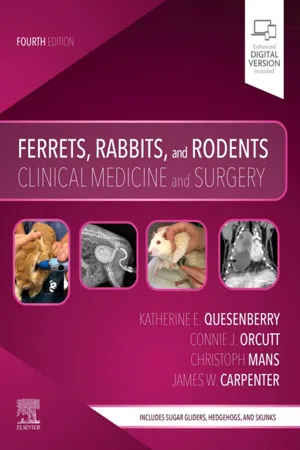
Ferrets, Rabbits and Rodents - E-Book
Clinical Medicine and Surgery
Katherine Quesenberry, Christoph Mans, Connie Orcutt, James W. Carpenter
- 656 páginas
- English
- ePUB (apto para móviles)
- Disponible en iOS y Android
Ferrets, Rabbits and Rodents - E-Book
Clinical Medicine and Surgery
Katherine Quesenberry, Christoph Mans, Connie Orcutt, James W. Carpenter
Información del libro
Learn to treat a wide variety of small mammals and pocket pets with Ferrets, Rabbits, and Rodents: Clinical Medicine and Surgery, 4th Edition. Covering the conditions most often seen in veterinary practice, this highly readable and easy-to-navigate text covers preventative medicine along with disease management, ophthalmology, dentistry, and zoonosis. More than 700 full-color photographs and illustrations highlight radiographic interpretation as well as diagnostic, surgical, and therapeutic techniques. This fourth edition also features new coverage of degus (large rodent species); new coverage of prairie dogs; and expanded coverage of surgical procedures, physical therapy rehabilitation and alternative medicine for rabbits, neoplasia in rabbits, and zoonotic disease. With expert contributors from around the globe, Ferrets, Rabbits, and Rodents is the authoritative, single point of reference for small mammal care that is hard to find elsewhere.
- Logical organization lays out sections by different animals and organizes parts within chapters by body system — making it quick and easy to access important information.
- Drug formulary provides dosage instructions for a wealth of species including ferrets, rabbits, guinea pigs, chinchillas, hamsters, rats/mice, prairie dogs, hedgehogs, and sugar gliders.
- More than 700 photographs and illustrations highlight key concepts such as radiographic interpretation and the main points of diagnostic, surgical, and therapeutic techniques.
- Chapter on ophthalmology provides an area of study that is difficult to find for ferrets, rabbits, rodents, and other small mammals.
- Chapter outlines offer an at-a-glance overview of the chapter contents at the beginning of the chapter.
- Access to Expert Consult site provides an excellent comprehensive reference and a fully searchable eBook.
- NEW! Coverage of surgical procedures has been further expanded in this edition. Surgical procedures are presented in a separate section and shown step by step through color photographs and radiographs, accompanied by line drawings.
- NEW! Additional information on physical therapy rehabilitation and alternative medicine for rabbits includes chiropractic care and acupuncture.
- NEW! Expanded content on neoplasia in rabbits incorporates lymphoreticular disorders, thymoma, and other neoplastic diseases of rabbits.
- NEW! All new chapter on prairie dogs has been added.
- NEW! All new chapter on degus (large rodent species) has been added.
- UPDATED! Chapter on zoonotic disease has been updated to further cover specific zoonotic diseases in addition to addressing the increased potential for disease transmission from animals to humans.
- NEW! Global author perspective incorporates the expertise of authors practicing outside of North America.
- UPDATED! Photographs show the diseases and disorders that are more commonly seen in practice.